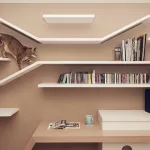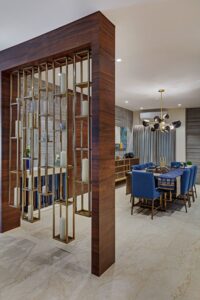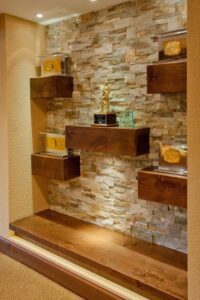Decoration Mistakes to Avoid for the Elegance of Your Home
Decorating your home is an exciting process, but it can also be a challenge. Often, people make mistakes in their design choices that detract from the elegance and beauty of their spaces. Whether you are working with a small apartment or a large home, the key to creating an elegant atmosphere lies in the details. Avoiding certain mistakes can elevate the look of your space and help you achieve the sophisticated and timeless design you’re aiming for.
Here are some common decoration mistakes to avoid when striving for a more elegant home:
1. Overcrowding Your Space with Furniture
Mistake: One of the most common mistakes in home decoration is overcrowding a space with too much furniture. While it may seem like filling the room with various pieces is the way to go, it often results in a cramped, cluttered look.
Solution: Keep furniture to a minimum and focus on functional, high-quality pieces. Choose furniture that complements the size and layout of the room. If the space is small, opt for streamlined, compact furniture that doesn’t overwhelm the area.
Why it Helps: Less clutter creates a sense of space and openness, allowing each piece to stand out. An elegant room should feel spacious and airy, where the furniture enhances the aesthetic rather than overpowering it.
2. Using Too Many Colors or Patterns
Mistake: A common mistake when decorating a home is using too many bold colors or mismatched patterns, which can create a chaotic, overwhelming effect.
Solution: Stick to a cohesive color palette with no more than three primary colors for walls, furniture, and decor. Use accent colors sparingly for pops of contrast, and mix patterns cautiously—ideally, stick to one or two patterns for each room.
Why it Helps: A more refined, neutral color palette with carefully chosen accents provides harmony and balance, which is key to achieving an elegant look. Subtle patterns and textures add depth without overwhelming the space.
3. Ignoring Proper Lighting
Mistake: Many homeowners focus primarily on furniture and decor while neglecting the importance of lighting. Poor lighting can make even the most beautiful room appear dull and uninviting.
Solution: Ensure your space has a combination of ambient, task, and accent lighting. Use statement light fixtures like chandeliers or pendant lights to elevate the room’s atmosphere. Additionally, floor lamps, table lamps, and recessed lighting can provide layered lighting for both function and style.
Why it Helps: Good lighting creates a warm and inviting atmosphere. Well-lit rooms with layered lighting add depth, highlight key design elements, and create a sense of elegance. Lighting can make a dramatic difference in the overall ambiance of your home.
4. Focusing Only on Trends
Mistake: Relying too much on current trends can make your home feel temporary or lose its timeless appeal. While trends can be fun, they often lack longevity.
Solution: Incorporate timeless design elements like neutral colors, classic furniture pieces, and enduring materials (wood, leather, stone). Use trendy items sparingly, mainly as accessories or accent pieces, to give your home a contemporary touch without compromising on style longevity.
Why it Helps: A balanced mix of classic and trendy items creates a home that feels both fresh and timeless. Your space will exude lasting elegance, allowing it to age gracefully over the years.
5. Neglecting the Walls
Mistake: Blank or bare walls can make a room feel incomplete. Wall decor is crucial to adding personality, style, and visual interest to a space. However, many people make the mistake of not paying attention to how to fill their walls properly.
Solution: Use wall art, mirrors, or shelves to create interest and dimension. Choose pieces that complement the color scheme and style of the room. Be sure to properly scale and hang artwork, ensuring it’s at eye level for maximum impact.
Why it Helps: Thoughtful wall decor adds character and elegance to your home. Properly chosen and arranged artwork or mirrors also help to reflect light and make the room feel larger and more open.
6. Overdecorating with Accessories
Mistake: Accessorizing is an important part of interior design, but overdecorating with too many small items can make your space feel cluttered rather than curated.
Solution: Choose a few statement accessories, such as vases, sculptures, or trays, and place them thoughtfully throughout the room. Avoid crowding surfaces and instead, let a few pieces stand out and shine.
Why it Helps: Elegant decor is all about restraint and purpose. By editing your accessories, you create a more polished look that feels sophisticated rather than chaotic.
7. Choosing Furniture That Doesn’t Fit the Space
Mistake: A common mistake is buying furniture that is too large or too small for a space. Overly large furniture can dominate the room, while too small pieces can make the room feel disjointed and lack cohesion.
Solution: Measure your space before purchasing furniture to ensure that each piece fits well within the room’s dimensions. Consider the scale of the furniture in relation to the size of the space to create a balanced look.
Why it Helps: Properly sized furniture enhances the functionality and aesthetic of the room. It allows for better flow and more comfort, contributing to the overall elegance of the design.
8. Skimping on Quality for Budget Reasons
Mistake: While it’s understandable to want to save money, cutting corners on key items like furniture, fixtures, or materials can result in a less polished look. Cheap furniture often looks flimsy or out of place, detracting from the overall elegance of the space.
Solution: Invest in quality pieces for items that will be used frequently, such as sofas, dining tables, and chairs. For items like accessories or accent decor, you can find stylish yet affordable options that don’t compromise on style.
Why it Helps: High-quality furniture and materials last longer and look more refined, which enhances the overall elegance of the space. In the long run, investing in quality pays off in terms of both durability and aesthetic appeal.
9. Forgetting to Mix Textures
Mistake: A room full of the same textures can feel flat and uninspired. While it’s essential to choose a cohesive color scheme, it’s equally important to layer different textures for depth and interest.
Solution: Combine soft textures like velvet or linen with more structured ones like leather, metal, or wood. Use textiles such as rugs, throw pillows, and curtains to create a variety of textures.
Why it Helps: Mixing textures creates visual contrast and makes the room feel more dynamic and inviting. A balance of different materials adds sophistication and warmth to your space.
10. Not Creating a Focal Point
Mistake: A room without a clear focal point can feel disorganized or lack a sense of direction. Whether it’s a statement piece of furniture, a striking piece of art, or an architectural feature, having a focal point is crucial to any design.
Solution: Determine the focal point of each room—whether it’s a large artwork, a fireplace, or a standout piece of furniture—and design the rest of the room around it. The other elements should complement and highlight this feature rather than compete with it.
Why it Helps: A well-defined focal point brings order and balance to a room, creating a more cohesive, elegant look. It naturally draws the eye and anchors the space, adding depth and interest.
Conclusion
Achieving an elegant home is all about making thoughtful choices that prioritize quality, simplicity, and harmony. By avoiding these common decorating mistakes, you can create a space that feels timeless, refined, and sophisticated. Remember, elegance lies in the details—proper furniture scaling, the right mix of colors and textures, and a focus on quality and functionality will ensure that your home exudes charm and grace.




